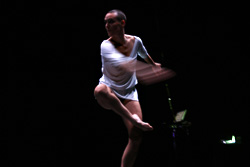The temptation, seeing an event that promises the “next” thing in modern dance, is to look for some overarching style or theme, like the predictions in a fashion magazine: This year skirts will be worn short, and dances will feature extended sequences of busy footwork. But last weekend’s Next Fest NW showed, as usual in an art form that emphasizes individual expression, that different dance makers are going in different directions, regardless of hemlines.
With Algoritmo, Trinidad Martinez was all about the tech, making a live version of a dance film by using rear-screen projection and a cleverly programmed Web camera to turn her dancing into animation. With the camera hanging above the stage capturing samples from her actions, the complication came in the translation: In the on-screen version of the dance, multiple images of the solo performer overlapped and repeated until the whole thing looked like the inside of a very busy beehive. Martinez’s collaborator, Dayton Allemann, is a programmer as well as a composer; he overdubbed a couple of flute notes and some lines of text in the same fashion as the movement, so that the original materials were lost in the complexity. Watching the patterns unfold and develop was great fun, like the best of puzzles, but eventually our attention was glued to the screen, leaving the dancing humans behind in favor of the pixelated version. When Allemann said “For musical reasons I have to say something, but it doesn’t matter what it is” into the microphone, we wondered if that statement might apply to the dancing as well.
Kristin Von Claret is a modern dancer whose first language was ballet, and it shows in her movement choices. There was a baseline competence in her trio, Subconscious Suites, that comes from ballet’s upright, locomotion-driven qualities, but that vocabulary didn’t always serve the purpose, especially when she chose steps best performed in pointe shoes. Beyond those glitches, though, was some thoughtful construction in her exploration of the differences between working alone or with a partner. The spoken text was salted with hints of domestic trivia (toilet paper) and family dynamics (“You look a lot more like Mom than I do”), so that by the work’s end, the three women onstage were siblings, not colleagues, embarked on the twitchy business of shifting alliances.
Pablo Cornejo’s Keeping Quiet opened with a beautifully introspective solo for Aleta Greenway, who made tying up her hair into a lovely dance of hands and arms. The rhythmic sway she began continued throughout the work; shifting in and out of a loose unison, the following quartet was full of impulse phrasing, in which an initial push either gathered momentum and tumbled across the space or gradually slowed and dissipated into stillness. The movement was sensual without preening, full of feelings without histrionics.
The four solos in Crispin Spaeth’s Wild Darling would have had a tender and bittersweet quality no matter the context, but since Spaeth recently announced she’s dissolving her company and moving on to other projects, they felt like her final words on the subject. Spaeth has often worked with some lovely and eccentric dancers, and continued that happy situation here. Sara Jinks began prone on the floor, surrounded by a little forest of tipped-over potted shrubs, and rose slowly, making careful adjustments of arms and legs, until finally the lights brightened as her face rose to look up. Spaeth herself, swaying in a long gown, circled around the plants, now all upright, while her arms spiraled in flamencolike shapes. Kathy Lawson and Heather Budd were bolder, surging close to the plants, moving them around and embracing them, until Budd ended the piece, looking back over her shoulder.
After this program came a separate set of dance films, a continuation of the New Dance Cinema programming that the late, lamented 33 Fainting Spells used to curate. The eight shorts were all over the map, from animated action figures (Spider-Man break dancing in Ezra Dickinson’s Spot) and dreamy seascapes to hidden-camera observations of everyday actions. Northwest Dance Syndrome and locust both showed films created for recent stage programs, with Syndrome’s force-feeding broken glass just as disturbing as it was originally, and the live-person variation of bunraku puppetry in locust’s Convenience still lurching through the kitchen, trying to complete a simple task with multiple hands where only two should be. Karn Junkinsmith is a witty manipulator of waiting behaviors in Bus Stop. The possibilities that film offers dance, to show a work that couldn’t exist on a stage, are tempting; both One Day, by John Dixon and Peggy Piacenza, and That a Universe My Heart May Unfold, by Luke Allen and Jessica Jobaris, live in worlds only tentatively related to the one we usually inhabit. But Project 1, by Angela Esposito and Graham Stockdale, leaves the real world for the world of the camera, altering time to the point that actions lose their usual dynamics and the dancer enters a weightless zone. It’s lovely, but in the end, you get a bit nostalgic for gravity.








